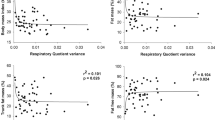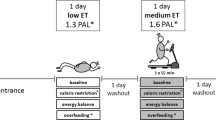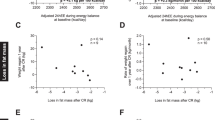Abstract
Background
Metabolic state (fed vs fasted) can result in marked differences in exercise metabolism, fat, and carbohydrate oxidation. In addition, a large inter-individual range in metabolic response to sitting and standing when fasted has been observed. Here, we examined the effect of metabolic state on the energy cost of posture allocation.
Methods
Thirty male participants were recruited and followed a 1 h sit-stand protocol in a fasted and fed state inside a whole body calorimeter to measure energy expenditure (EE) and respiratory quotient (RQ). Body composition and resting metabolic rate were measured before the start. Fasted EE response was used to phenotype participants as energy savers (≤5% ΔEE from sitting to standing) or energy spenders (>5% ΔEE).
Results
In a fasted state, ΔEE from sitting to standing in energy spenders was 10.2 ± 2.7% compared to 2.6 ± 1.9% in energy savers (p < 0.001). Postprandial, there was no difference in ΔEE between energy spenders and energy savers (10.8 ± 5.1% vs 9.4 ± 5.7%). In a fasted state, significant correlations were observed between body fat (%) and ΔEE (%) (R2 = 0.55, p < 0.001), body fat (%) and ΔRQ (R2 = 0.28, p < 0.001) and ΔEE (%) and ΔRQ (R2 = 0.43, p < 0.001); these correlations were not present after the meal.
Conclusions
The current study showed for the first time, that the observed difference between energy spenders and energy savers in a fasted state, disappeared after the consumption of a meal. Therefore, metabolic state may be important to consider when assessing metabolic phenotypes. Differences in body composition were observed between the energy spender and energy saver phenotype. The current findings may have implications on health and weight management recommendations on posture to increase non-exercise activity thermogenesis.
This trial was retrospectively registered on 19 December 2017 as NCT03378115 on Clinicaltrials.gov.
This is a preview of subscription content, access via your institution
Access options
Subscribe to this journal
Receive 12 print issues and online access
$259.00 per year
only $21.58 per issue
Buy this article
- Purchase on Springer Link
- Instant access to full article PDF
Prices may be subject to local taxes which are calculated during checkout




Similar content being viewed by others
Data availability
The datasets used and analyzed during the current study are available from the corresponding author on reasonable request.
References
Goh LG, Pang J. Obesity in Singapore, prevention and control. Singap Fam Phys. 2012;38:8–13.
Hopkins M, Blundell JE. Energy balance, body composition, sedentariness and appetite regulation: pathways to obesity. Clin Sci (Lond). 2016;130:1615–28.
Hills AP, Arena R, Khunti K, Yajnik CS, Jayawardena R, Henry CJ, et al. Epidemiology and determinants of type 2 diabetes in south Asia. Lancet Diabetes Endocrinol. 2018;6:966–978.
Jepson R, Harris FM, Bowes A, Robertson R, Avan G, Sheikh A. Physical activity in South Asians: an in-depth qualitative study to explore motivations and facilitators. PLoS ONE. 2012;7:e45333.
Li F, Liu Y, Lu J, Liang L, Harmer P. Ambient air pollution in China poses a multifaceted health threat to outdoor physical activity. J Epidemiol Community Health. 2015;69:201–4.
Perri MG, Anton SD, Durning PE, Ketterson TU, Sydeman SJ, Berlant NE, et al. Adherence to exercise prescriptions: effects of prescribing moderate versus higher levels of intensity and frequency. Health Psychol. 2002;21:452–8.
Hills AP, Byrne NM. Exercise prescription for weight management. Proc Nutr Soc. 1998;57:93–103.
Goh HJ, Govindharajulu P, Camps SG, Tan SY, Henry CJ. Gross and relative energy cost of domestic household activities in Asian men. Eur J Clin Nutr. 2016;70:1414–9.
Levine JA. Non-Exercise Activity Thermogenesis (NEAT). Nutr Rev. 2004;62:S82–S97.
Zurlo F, Ferraro RT, Fontvielle AM, Rising R, Bogardus C, Ravussin E. Spontaneous physical activity and obesity: cross-sectional and longitudinal studies in Pima Indians. Am J Physiol. 1992;263:E296–300.
Johannsen DL, Ravussin E. Spontaneous physical activity: relationship between fidgeting and body weight control. Curr Opin Endocrinol Diabetes Obes. 2008;15:409–15.
Miles-Chan JL, Dulloo AG. Posture Allocation Revisited: Breaking the Sedentary Threshold of Energy Expenditure for Obesity Management. Front Physiol. 2017;8:420.
Saeidifard F, Medina-Inojosa JR, Supervia M, Olson TP, Somers VK, Erwin PJ, et al. Differences of energy expenditure while sitting versus standing: a systematic review and meta-analysis. Eur J Prev Cardiol. 2018:2047487317752186.
Miles-Chan JL, Sarafian D, Montani JP, Schutz Y, Dulloo A. Heterogeneity in the energy cost of posture maintenance during standing relative to sitting: phenotyping according to magnitude and time-course. PLoS ONE. 2013;8:e65827.
Monnard CR, Miles-Chan JL. Energy Cost of Standing in a Multi-Ethnic Cohort: Are Energy-Savers a Minority or the Majority? PLoS ONE. 2017;12:e0169478.
Aird TP, Davies RW, Carson BP. Effects of fasted vs fed-state exercise on performance and post-exercise metabolism: a systematic review and meta-analysis. Scand J Med Sci Sports. 2018;28:1476–93.
Vieira AF, Costa RR, Macedo RC, Coconcelli L, Kruel LF. Effects of aerobic exercise performed in fasted v. fed state on fat and carbohydrate metabolism in adults: a systematic review and meta-analysis. Br J Nutr. 2016;116:1153–64.
Baecke JA, Burema J, Frijters JE. A short questionnaire for the measurement of habitual physical activity in epidemiological studies. Am J Clin Nutr. 1982;36:936–42.
Van Strien T, Frijters JE, Bergers GP, Defares PB. The Dutch Eating Behavior Questionnaire (DEBQ) for assessment of restrained, emotional, and external eating behavior. Int J Eat Disord. 1986;5:295–315.
Schoffelen PF, Westerterp KR, Saris WH, Ten Hoor F. A dual-respiration chamber system with automated calibration. J Appl Physiol. 1997;83:2064–72.
Geissler CA, Aldouri MS. Racial differences in the energy cost of standardised activities. Ann Nutr Metab. 1985;29:40–7.
Strickland SS, Ulijaszek SJ. Energetic cost of standard activities in Gurkha and British soldiers. Ann Hum Biol. 1990;17:133–44.
Browning JD, Baxter J, Satapati S, Burgess SC. The effect of short-term fasting on liver and skeletal muscle lipid, glucose, and energy metabolism in healthy women and men. J Lipid Res. 2012;53:577–86.
Rui L. Energy metabolism in the liver. Compr Physiol. 2014;4:177–97.
Biswas A, Oh PI, Faulkner GE, Bajaj RR, Silver MA, Mitchell MS, et al. Sedentary time and its association with risk for disease incidence, mortality, and hospitalization in adults: a systematic review and meta-analysis. Ann Intern Med. 2015;162:123–32.
Proper KI, Singh AS, van Mechelen W, Chinapaw MJ. Sedentary behaviors and health outcomes among adults: a systematic review of prospective studies. Am J Prev Med. 2011;40:174–82.
Zhao R, Bu W, Chen Y, Chen X. The dose-response associations of sedentary time with chronic diseases and the risk for all-cause mortality affected by different health status: a systematic review and meta-analysis. J Nutr Health Aging. 2020;24:63–70.
Prentice AM, Jebb SA. Obesity in Britain: gluttony or sloth? BMJ 1995;311:437–9.
Levine JA, Lanningham-Foster LM, McCrady SK, Krizan AC, Olson LR, Kane PH, et al. Interindividual variation in posture allocation: possible role in human obesity. Science 2005;307:584–6.
Veerman JL, Healy GN, Cobiac LJ, Vos T, Winkler EA, Owen N, et al. Television viewing time and reduced life expectancy: a life table analysis. Br J Sports Med. 2012;46:927–30.
Katzmarzyk PT, Lee IM. Sedentary behaviour and life expectancy in the USA: a cause-deleted life table analysis. BMJ Open. 2012;2:e00082,1–8.
Win AM, Yen LW, Tan KH, Lim RB, Chia KS, Mueller-Riemenschneider F. Patterns of physical activity and sedentary behavior in a representative sample of a multi-ethnic South-East Asian population: a cross-sectional study. BMC Public Health. 2015;15:318.
Judice PB, Hamilton MT, Sardinha LB, Zderic TW, Silva AM. What is the metabolic and energy cost of sitting, standing and sit/stand transitions? Eur J Appl Physiol. 2016;116:263–73.
Kallings LV, Blom V, Ekblom B, Holmlund T, Eriksson JS, Andersson G, et al. Workplace sitting is associated with self-reported general health and back/neck pain: a cross-sectional analysis in 44,978 employees. BMC Public Health. 2021;21:1–9.
Miles-Chan JL, Fares EJ, Berkachy R, Jacquet P, Isacco L, Schutz Y, et al. Standing economy: does the heterogeneity in the energy cost of posture maintenance reside in differential patterns of spontaneous weight-shifting? Eur J Appl Physiol. 2017;117:795–807.
Westerterp KR. Diet induced thermogenesis. Nutr Metab (Lond). 2004;1:5.
Acknowledgements
The authors thank the participants for their participation in this study.
Funding
This research was supported by the Agency for Science, Technology and Research (A*STAR) and there was no additional external financial support.
Author information
Authors and Affiliations
Contributions
CJH and SGC conceived and designed the experiments; HRK and SGC performed the experiments; HRK and SGC analyzed the data; SGC wrote the paper; CJH reviewed the paper and had primary responsibility for the final content.
Corresponding authors
Ethics declarations
Competing interests
The authors declare no competing interests. A*Star did not play a role in the collection, analysis, and interpretation of the data.
Ethics approval and consent to participate
Ethical approval for all procedures involving human participants was obtained from the National Healthcare Group Domain Specific Review Board (NHG DSRB). The research procedures and trial protocols were followed in accordance to the good clinical practice (GCP) guidelines and with the ethical standards in concordance to the Declaration of Helsinki, 1983. Written informed consent for participation was obtained from all eligible participants before commencement.
Consent for publication
Written informed consent for data publication was obtained from all eligible participants before commencement.
Additional information
Publisher’s note Springer Nature remains neutral with regard to jurisdictional claims in published maps and institutional affiliations.
Supplementary information
Rights and permissions
About this article
Cite this article
Camps, S.G., Koh, H.R. & Henry, C.J. Posture economy: the importance of metabolic state on metabolic phenotype assessment and the energy cost of sitting and standing. A whole body calorimetry trial. Eur J Clin Nutr 76, 1178–1185 (2022). https://doi.org/10.1038/s41430-022-01077-7
Received:
Revised:
Accepted:
Published:
Issue Date:
DOI: https://doi.org/10.1038/s41430-022-01077-7
This article is cited by
-
Weight loss does not affect the sit-to-stand metabolic cost in adolescents with obesity
European Journal of Applied Physiology (2023)



